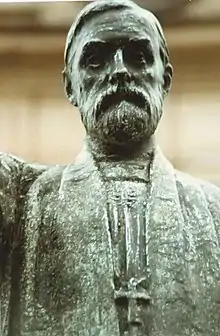Thomas Stirling Lee
Thomas Stirling Lee (London, 16 March 1857 – 29 June 1916, London) was an English sculptor, specialising in reliefs and portrait heads.[1]
Thomas Stirling Lee | |
|---|---|
| Born | 16 March 1857 |
| Died | 29 June 1916 (aged 59) St George's Hospital, Knightsbridge, London, England |
| Nationality | English |
| Education | |
| Known for | Sculpture |
| Elected |
|
Early life
Lee was born in Lambeth, London on 16 March 1857, the son of John Swanwick Lee, a surveyor.[2] He was educated at Westminster School and then served as an apprentice in the studio of John Birnie Philip.[2][3]
Lee studied at the Royal Academy Schools from 1876 to 1880, where he won both a Gold Medal and a Travelling Scholarship.[1] In 1880–1881 he studied under Pierre-Jules Cavelier at the École des Beaux-Arts in Paris, and then studied in Rome until 1883.[1]
Career
Lee's commission for 28 panels for the exterior of St George's Hall, Liverpool, resulting from an open competition held by Liverpool City Council in 1882,[2] is regarded as his most important,[2] but it was the subject of controversy,[2] when the first two featured naked girls,[2] depicting "the child Justice" and "the girl Justice".[3] Lee only completed six of the 28 panels, but was subsequently commissioned to make two, and oversee all, of a further set of six on the theme of 'National Prosperity'.[2]
He was a member of the National Portrait Society from 1910 to 1915,[1] a member of the Chelsea Arts Club[2] and a member of the International Society of Sculptors, Painters and Gravers.[4]
Lee died at St George's Hospital, Knightsbridge, London[2] on 29 June 1916.[5] His friends subscribed to a fund for a bronze panel on the family vault at New Southgate.[2]
Works

Lee's work includes:
- Bas-reliefs for Leeds Town Hall[1]
- Carvings for Westminster Cathedral[1]
- Bronze statue of Charles Gore, First Bishop of Birmingham, outside Birmingham Cathedral (1914)[6] - 52.48106°N 1.89821°W
- The Progress of Justice series of bas reliefs, left of the central portico on Saint George's Hall, Liverpool,[3] 1885–1894
- The National Progress series, right of the portico on Saint George's Hall,[3] 1898–1901
- Doors with scenes of male friendship, Adelphi Bank, Liverpool[3]
References
- "Thomas Stirling Lee". Tate. Retrieved 31 May 2013.
- "Thomas Stirling Lee". Mapping the Practice and Profession of Sculpture in Britain and Ireland 1851–1951. Glasgow University. Retrieved 31 May 2013.
- "Thomas Stirling Lee". The Victorian Web. 2013-04-12. Retrieved 31 May 2013.
- "The International Society of Sculptors, Painters and Gravers". Mapping the Practice and Profession of Sculpture in Britain and Ireland 1851–1951. Glasgow University. Retrieved 31 May 2013.
- Waters, Grant M. (1974). Dictionary of British Artists Working 1900–1950. Eastbourne: Eastbourne Fine Art.
- Noszlopy, George T. (1998). Public Sculpture of Birmingham including Sutton Coldfield. Public Sculpture of Britain. 2. Liverpool University Press. ISBN 0-85323-682-8.
